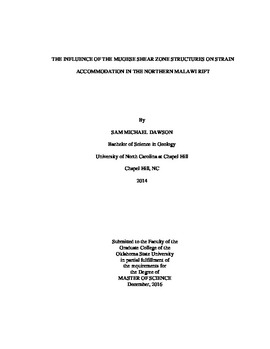| dc.contributor.advisor | Lao Davila, Daniel | |
| dc.contributor.author | Dawson, Sam Michael | |
| dc.date.accessioned | 2018-06-29T14:40:56Z | |
| dc.date.available | 2018-06-29T14:40:56Z | |
| dc.date.issued | 2016-12-01 | |
| dc.identifier.uri | https://hdl.handle.net/11244/300339 | |
| dc.description.abstract | The Livingstone border fault, with its 7 km of maximum displacement, accommodates most of the extension in the northern portion of the N-striking Malawi Rift (the southern segment of the Western Branch of the East African Rift System (EARS)) through the development of an E-dipping half-graben. However, the 2009 earthquake sequence in the greater Karonga area, west of the Livingstone border fault, suggests that extension is also being accommodated in the hanging-wall of the half-graben. This hanging wall block is underlain in part by the NW- and N-striking Precambrian Mugese Shear Zone (MSZ) and N-striking Karoo-age (Paleozoic – Mesozoic) rift structures. We used aeromagnetic data to map the Precambrian macro-scale structural fabric of the greater Karonga region. Moreover, we mapped mesoscopic-scale structures within the Precambrian and younger rocks in the region. Additionally, we used Shuttle Radar Topography Mission (SRTM) Digital Elevation Models (DEM) to map rift-related brittle structures. We found that in the northern portion of the Karonga Fault Zone, a fault zone that accommodates the majority of extension in this region, one major fault is oriented 32°/ 59° SE which cuts across the Precambrian foliation that has an orientation of 301°/ 79° NE. South of the city of Karonga, the Precambrian foliation is sub-vertical and has a strike of 321°. Here, the Karonga fault splays from a main fault with a 2 km damage zone to several distinct E-and W-dipping faults over a 10 km zone that strike in the general direction of the foliation planes of the MSZ. The N-striking Karoo rift horsts and grabens and their associated rock formations might have also been reactivated in this area. These relationships suggest that within the northern Malawi Rift, extension was accommodated differently based on the nature and orientation of the pre-existing structures. The Precambrian and Paleozoic-Mesozoic structural fabric underlying the southern portion of the Karonga Fault Zone favors accommodation of slip along pre-existing planes, whereas strain is localized in a narrow zone in the northern portion of the fault zone and is not accommodated through reactivation of pre-existing structures. | |
| dc.format | application/pdf | |
| dc.language | en_US | |
| dc.rights | Copyright is held by the author who has granted the Oklahoma State University Library the non-exclusive right to share this material in its institutional repository. Contact Digital Library Services at lib-dls@okstate.edu or 405-744-9161 for the permission policy on the use, reproduction or distribution of this material. | |
| dc.title | Influence of the Mugese Shear Zone Structures on Strain Accommodation in the Northern Malawi Rift | |
| dc.contributor.committeeMember | Abdelsalam, Mohamed | |
| dc.contributor.committeeMember | Atekwana, Estella | |
| osu.filename | Dawson_okstate_0664M_14874.pdf | |
| osu.accesstype | Open Access | |
| dc.description.department | Geology | |
| dc.type.genre | Thesis | |
| dc.type.material | text | |
